The Polynesian Cultural Center’s kalo consultant
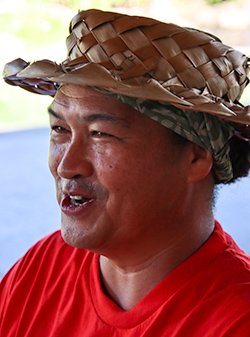
Lono Logan. Photos by Mike Foley
The significance of poi in Hawaiian culture cannot be understated. It is still very much an important and favorite food for many modern Hawaiians and can be purchased in most local grocery stores.
Meet Lono Logan, a member of a prominent Hawaiian family in Laie, Hawaii. Some might say he literally grew up at the Polynesian Cultural Center. It turns out his grandparents, the late Jubilee and Eugenia Logan, helped build and man the Hawaii Village at the Center. Little Lono could often be found here back in the 1960s and 70s hanging out with a few other staff kids and helping his grandma.
In fact, he says one of his earliest memories is of his tutu placing his hands on a poi pounder, wrapping her arms around him from behind, and guiding him in how to mash boiled kalo (or taro) roots into the traditional Hawaiian food staple poi.
Lono’s grandparents have long since passed away, but their influence in his life remains strong. At one point he wanted to be a commercial photographer, but about 10 years ago he says his grandma’s example led him back to kalo farming and making poi.
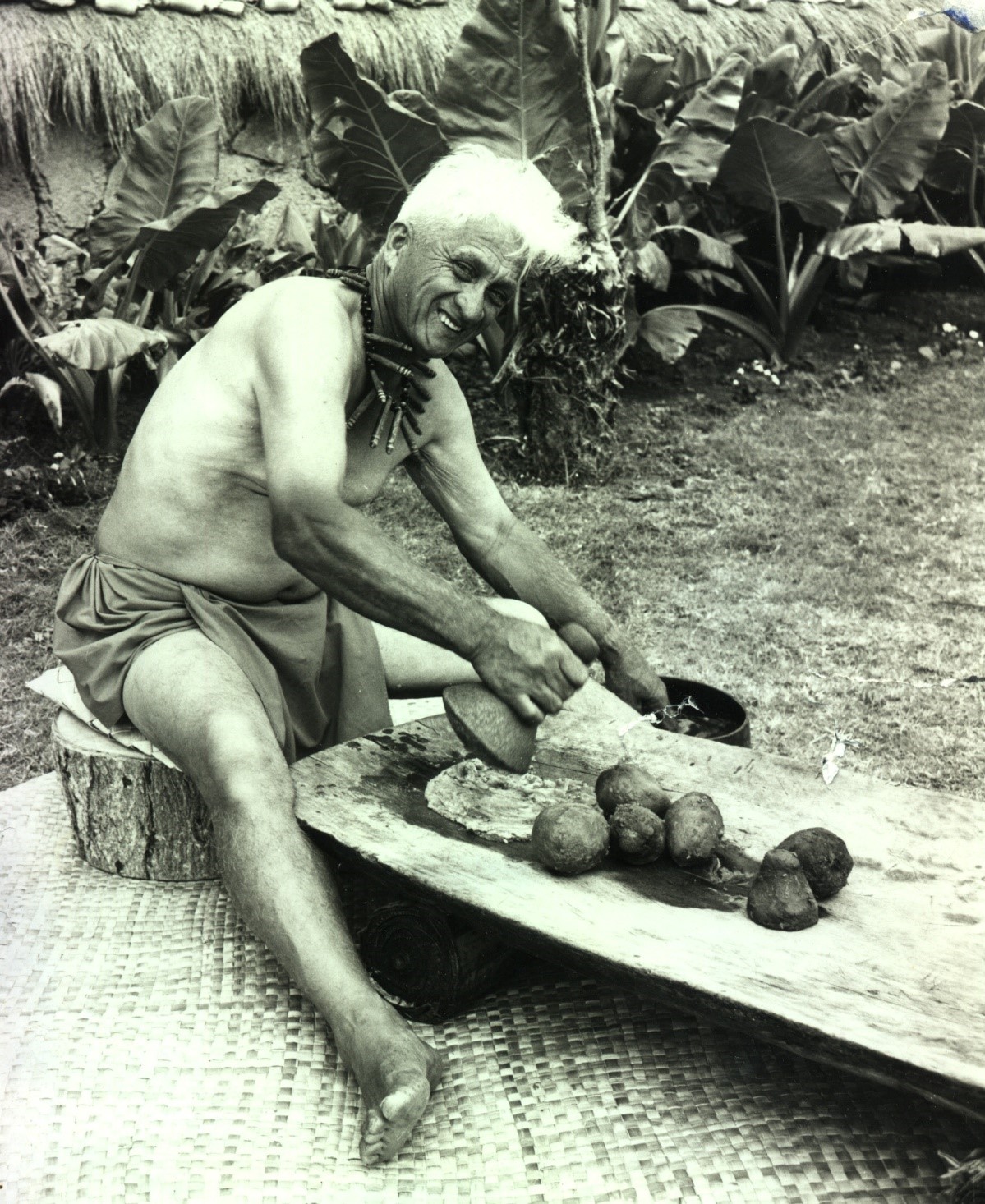
Jublilee Logan, pounding poi in the Hawaii Village
He recalls about four or five years ago he started to help demonstrate poi pounding at a couple of sponsored events, but adds he still wasn’t thinking of working at the Center at that point.
“Then I started to feel the pull of our ancestors. I heard my grandmother’s voice saying, ‘Sonny, you need to kokua (help with the)] kalo in the Hawaiian Village.’” Since this past December, he has done an impressive job as the Center’s kalo consultant and loves it.
“A week after I started doing this at the Polynesian Cultural Center, I felt my grandma again, and I knew I’m doing the right thing here,” said Logan.
During that time, he has worked with the leaders and the BYU–Hawaii student workers in the Hawaiian Village to plant 30-plus varieties of the approximately 60 varieties of kalo now commonly grown in Hawaii.
Guests can see these thriving in four loi (taro patches) alongside a small stream in the village. He made sure some of the water upstream flows through the lo’i. Lono says this makes all the difference and his freshly pounded poi, as the Hawaiians say, is ono (very delicious).
Kalo’s origins in Hawaiian legend
“For Hawaiians, kalo is part of our existence,” Logan briefly explains about ancient mythology. “Sky Father, Wakea, and Earth Mother, Papa, have a daughter, Hoohokukalani. Later Hoohokukalani and Wakea produce a son, Naloa Naka, who is stillborn. They bury the fetus and over time, the mother’s tears shower that area, and the original kalo plant grows. Its original name was Haloanakalaukapalili [which describes the young plant from its ha [breath/stem] loa [long breath] nakalau [young leaf unfolding] kapalili [opened leaf that bends down and quivers in the wind].
Hoohokukalani’s second child is a healthy baby boy, Haloa — the first kanaka [man], the first male. We all stem from him. For Hawaiians, kalo is not just some pretty plant, it’s our ancestor.
On growing Hawaiian kalo
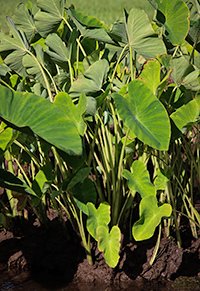
Young taro growing in the loi.
“So, how do we treat grandparents?” he asks. “You give them the best! Ao when you grow kalo, it should be with that same attention and care.”
Lono explains kalo growing loi style prefers cold flowing water. “Ideally I would like to have the water in our Hawaiian Village loi be fed from a punawai [spring].” He notes there are several in the area and the Center was built on top of ancient loi.
When conditions are ideal (depending on the variety of kalo, its health, care and available resources) “it generally takes about seven-to-12 or more months for kalo to grow in a loi,” starting from about ankle-high when it’s first planted, “hip-high at about five months, and as much as head-high at about 10 months.”
Lono adds that because the earth is warmer, “dry-land” taro varieties (i.e. planted in the ground without water flowing past it), it may take two to three months less time to mature, depending on environmental factors such as elevation, prevailing temperatures, etc.
“You want to pull it at the peak of its starchiness–too long and the starch turns to sugar. Normally, you would just eat that kind. Otherwise, when you go to pound it, it’s too lumpy. Quality control comes through trial and error,” he says.
How to make poi
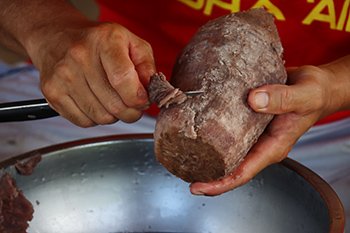
Logan scrapes his boiled kalo twice.
Because the Center’s Hawaiian Villagers make poi and share samples every day with hundreds, sometimes thousands of guests, they usually purchase large bags of kalo from outside farmers as often as needed.
1. Pressure cook the kalo
Logan brings out about a two-pound tuber root he pulled from the loi and washed the day before. Leaving the skin on, he cooked it earlier that morning in a pressure cooker (at about five pounds or psi) for about 75 minutes. Otherwise, he says it might have taken over two hours of regular boiling to cook it; and he stresses several times that others may have different ways of preparing their kalo and poi.
2. Peel off skin and put waste in loi
After the kalo cools, he places it in a bowl of cool water. The skin easily sloughs off in his hands. He says the skin will get thrown back into the loi to provide additional nutrients. “Also, when I was pulling this out, I stomped the roots back into the loi to add back micronutrients.”
3. Scrape outter flesh of kalo and cut into pieces
Next, he lightly scrapes the kalo with a knife twice. “The old Hawaiians used an opihi [limpet] shell.” The first scrapings, while digging out any imperfections, is saved to feed to chickens or pigs. The second scraping goes a little deeper. “This is what we call koena. Some people eat this or use it like a thickener [similar to using corn starch] in stews.” Then he cuts the kalo into manageably sized pieces and puts them on the pounding board. Now he’s ready to begin pounding.
4. Pound the kalo
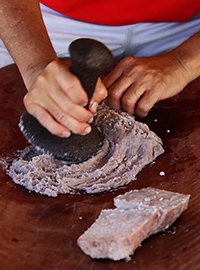
Pounding the taro
Logan uses a pohaku ai fashioned out of lava rock plus a modern innovation, a plastic scraper. He points out that he uses very little water when he makes his poi but wets the pounder occasionally so that the poi doesn’t stick to it and build up.
At first, he gently breaks the kalo up with the ka’e (edge) of the pounder. At this stage, he has made lumpy pai ai, which some people prefer to eat. It’s more like the whole-cooked taro other Polynesians usually eat.
Then using the smooth, rounded mole (end) of the pounder, Logan pushes and presses all the lumps out, again wetting the pounder and the scraper. Finally, he starts vigorously pounding the poi, rhythmically pushing it into a lump with one hand before bringing the pounder down with the other. The resulting fresh poi is surprisingly thick, sticky and a little sweet (optional).
While Logan likes it this way, he admits others may add more water, or even salt, soy sauce or sugar. Older Hawaiians, he says, tended to like “sour” (fermented) poi, which might have been a natural result of no refrigeration back then.
Now a days, it’s common to talk about day-old or two-day-old poi, etc. “Some families even had an umeke [or calabash] to which they just kept adding more fresh poi, allowing the remainder of previous batches to help bump up the sour flavor. You never threw out the old poi,” he says.
Sample freshly prepared poi, our staple of life
“If you don’t know what kalo is, please come see our demonstration in the Hawaiian Village,” Logan concludes. “We will explain how significant it is to Hawaiians and the rest of Polynesia. Poi is very nutritional and safe. It doesn’t need refrigeration, and I believe sampling freshly pounded poi might remove any misconceptions you might have about it. We’ll do our best to educate you about kalo and poi and let you experience it for yourself.”
 Story and photos by Mike Foley, who has been associated with the Polynesian Cultural Center for over 50 years. He had a long career in marketing communications, PR, journalism and university education before becoming a full-time freelance writer and digital media specialist in 2002.
Story and photos by Mike Foley, who has been associated with the Polynesian Cultural Center for over 50 years. He had a long career in marketing communications, PR, journalism and university education before becoming a full-time freelance writer and digital media specialist in 2002.
Foley learned to speak fluent Samoan as a Latter-day Saint missionary before moving to Laie in 1967, and he still does. He has traveled extensively over the years throughout Polynesia, other Pacific islands and Asia. Though mostly retired, Foley continues to contribute to the Polynesian Cultural Center and a select few other media.
He first ate baked taro during a feast on the very first day he arrived in American Samoa in 1965 and has loved it ever since. Occasionally he’ll eat Hawaiian-style poi. His wife, on the other hand, likes sour poi. One of her Hawaiian ancestors would wait until the poi started to bubble [i.e. ferment] after about seven days in the calabash before he would eat it.

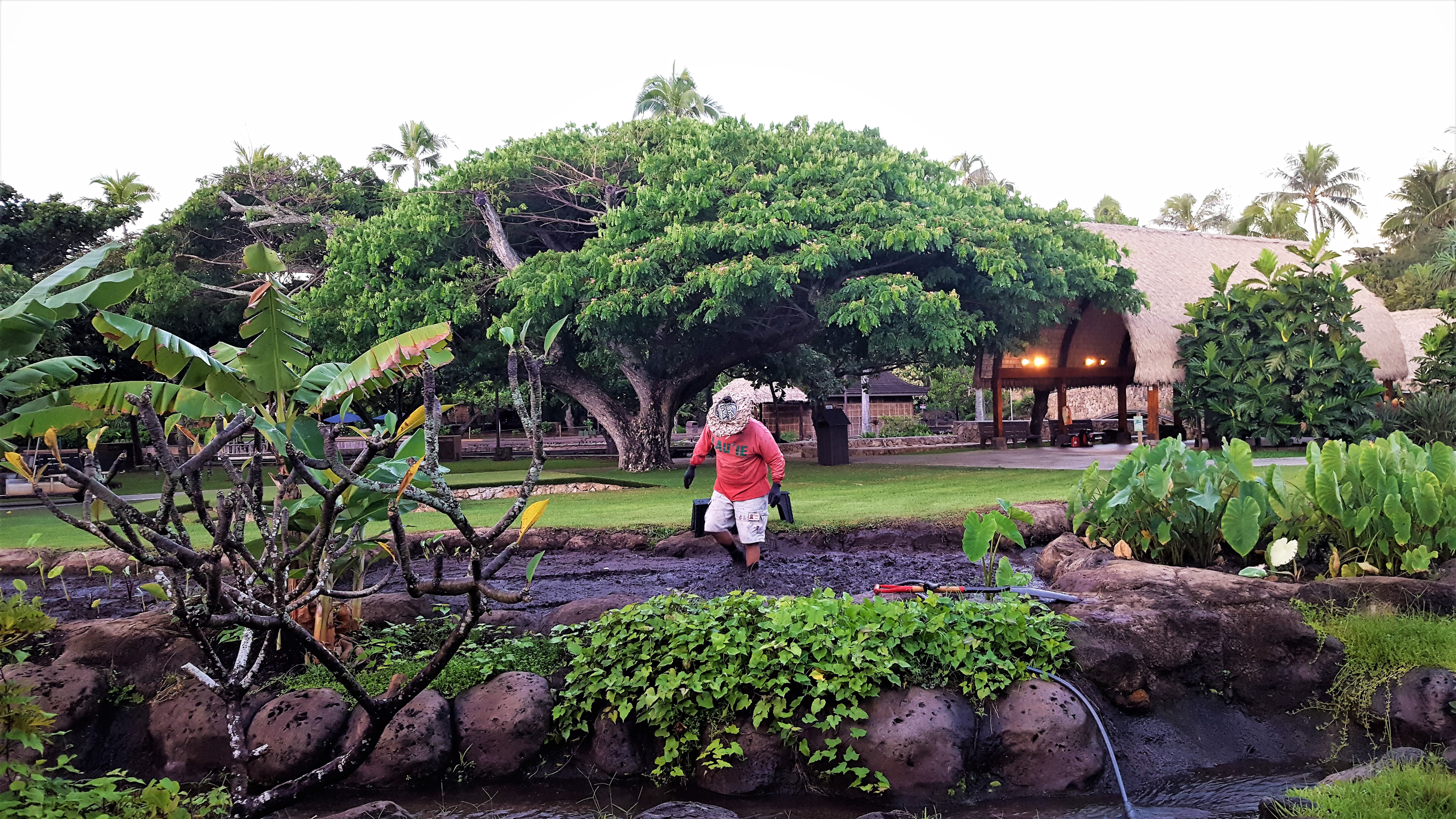
Hi Thanks for sharing the information about the traditional taro farming